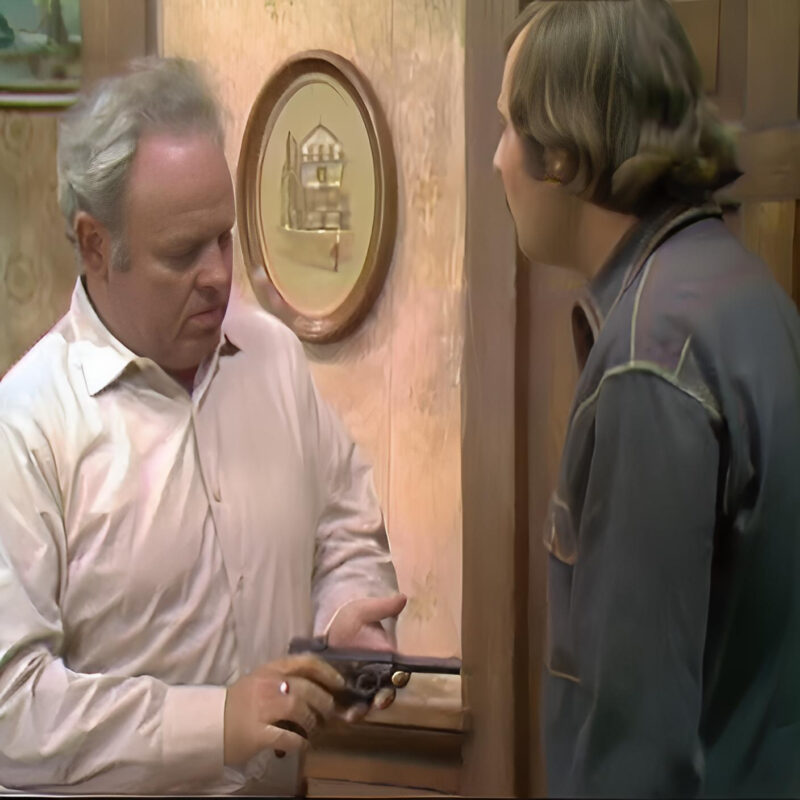
The two rickety pieces of furniture, well-worn even before their purchase at a secondhand store for less than $10, became iconic symbols of one of television’s most revolutionary shows, All in the Family, which premiered 50 years ago.
Despite their humble appearance, the chairs of Archie and Edith Bunker were akin to thrones for the working-class family from Queens. Archie’s wing chair, with its faded brown upholstery, signified his dominant role as the bigoted patriarch. Edith’s smaller chair, with wooden arms, helped her spring up to fetch Archie another beer on demand. Jean Stapleton’s Edith maintained the peace between her husband, Carroll O’Connor’s Archie, and their feminist daughter Gloria, played by Sally Struthers, and her liberal husband Michael Stivic, portrayed by Rob Reiner.
The generational clashes within the household, which defined the series over its nine seasons in the 1970s, mirrored and satirized the political and social divisions in America at the end of the 1960s. Produced by Norman Lear and Bud Yorkin, the show boldly addressed topical issues of the day, confronting the festering divisions in American families head-on.
“When you look at television history, you can divide it into two eras: before Norman and after Norman,” says Jim Colucci, co-author with Lear of the forthcoming All in the Family book. “The show changed everything.”
The modest chairs, now displayed behind plexiglass at the Smithsonian’s National Museum of American History, are second only to Judy Garland’s ruby slippers from The Wizard of Oz as the museum’s pop culture must-see items. “It’s one of the things people know we have—even more so than Abraham Lincoln’s hat or George Washington’s uniform,” says Ryan Lintelman, the museum’s curator of entertainment.
The arrival of the Bunker chairs at the museum also marked a pivotal change in the Smithsonian’s approach to collecting artifacts, expanding from strictly historical items to include iconic cultural touchstones. “This was one of the first accessions related to popular culture and entertainment,” Lintelman explains. The museum’s new Bicentennial exhibition, “A Nation of Nations,” reflected social and cultural history, including entertainment. “This was the first television acquisition we made, so it was a big deal,” Lintelman says. “It was a watershed moment in the history of the Smithsonian.”
All in the Family premiered in 1971, reflecting the cultural divide of the 1960s and setting itself apart from anything else on TV. The first episode was prefaced with a disclaimer, warning that the show “seeks to throw a humorous spotlight on our frailties, prejudices, and concerns. By making them a source of laughter, we hope to show—in a mature fashion—just how absurd they are.”
From the start, Archie used all kinds of stereotypes, with the show testing boundaries like no other. No topic—from menopause and impotence to rape and sexual assault—was off the table. The show also featured one of TV’s first gay characters. “They fought to get storylines about all these topics on the air, on this daring new show,” Colucci says.
Sally Struthers, who won two Emmy Awards for her role as Gloria Stivic, recalls being shocked by Archie’s racist epithets. “I kept having to ask what they meant.”
Initially, no one knew how the show would be received. “We were told that all of the CBS affiliates had extra operators to handle angry phone calls,” Struthers says. “But fortunately for us, 90 percent or more were excited.”
The show’s stars Carroll O’Connor and Jean Stapleton were chosen to open that year’s Emmy broadcast, and the new show picked up three awards. From then on, All in the Family became a cultural phenomenon and a ratings leader throughout its nine-year run, redefining what a TV sitcom could be. Earlier sitcoms were rural amusements like The Beverly Hillbillies and Green Acres, but Lear’s daring show brought a new liberation to television in the 1970s.
Struthers recalls the director warning the cast about the upcoming fame. “He told us, ‘I want you to know and be prepared that your lives are going to change.’”
Indeed, the cast could no longer go unnoticed in public. Struthers remembers fans mobbing her mother, Jean Stapleton, in Hawaii. “It was an incredible outpouring of love and appreciation,” Pamela Putch, Stapleton’s daughter, says.
The central set pieces—the two Bunker chairs—were ceremoniously given to the Smithsonian in 1978. As Lear recalls in his memoir, President Carter invited the cast to the White House, where he discussed memorable episodes. The event included visits to Congress and the White House, a ceremony hosted by Bette Davis, and a wild afterparty featuring Walter Cronkite.
Despite the celebration, the chair donation faced a hitch. The network ordered a ninth season after the chairs were donated, leading to the creation of replicas for the final season, costing over $15,000 to recreate the original fabric and appearance.
The chairs have only left the Smithsonian once, for Norman Lear’s Kennedy Center Honors in 2017, where Rob Reiner was once again scolded for trying to sit in Archie’s chair, just as he had been decades earlier.
The National Museum of American History, currently closed due to Covid-19 concerns, plans to feature the All in the Family chairs in the upcoming exhibition “Entertaining America,” scheduled to open in 2022.
